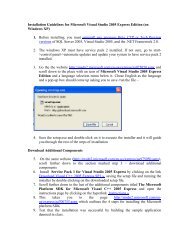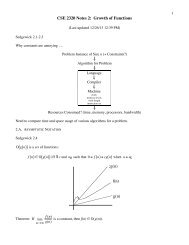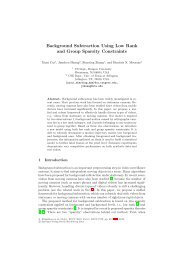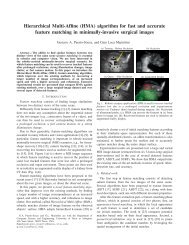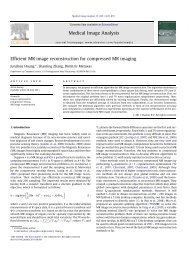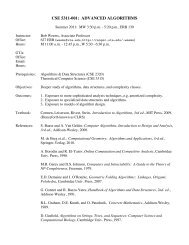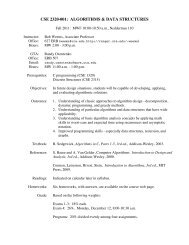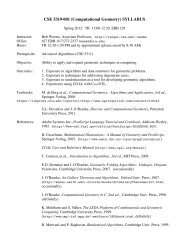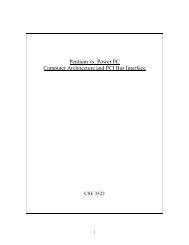Quiz 2 for CSE4344 Computer Network Organization
Quiz 2 for CSE4344 Computer Network Organization
Quiz 2 for CSE4344 Computer Network Organization
You also want an ePaper? Increase the reach of your titles
YUMPU automatically turns print PDFs into web optimized ePapers that Google loves.
<strong>Quiz</strong> 2 <strong>for</strong> <strong>CSE4344</strong> <strong>Computer</strong> <strong>Network</strong> <strong>Organization</strong>10/15/13use back of this page if more space is neededNAME:ID:1. What are the two transport layer protocols in the current Internet? Which one of them if connectionless?(5points)UDP and TCP. UDP is connectionless.2. Suppose Host A and Host B both sends UDP datagrams to the same port number on Host C. Will the datagramsbe delivered to the same socket? Why? (5 points)Yes. UDP socket is identified by 2-tuple, destination addr and port number.Suppose Host A and Host B both sends TCP segments to the same port number on Host C. Will the segmentsbe delivered to the same socket? Why? (5 points)No. TCP socket is identified by 4 tuple, source/dest addr, souce/dest port number.3. What is the purpose of the checksum field in the TCP header? (5 points)to detect errors of the TCP packet.4. In Go-Back-N protocol, only one timeout timer (<strong>for</strong> the oldest unACKed packet) is maintained at the sender.Can you explain why this is sufficient? (10 points)In go-back-n, if the oldest unacked packet experiences a time out, all the succeeding packets will have to beretransmitted.5. Suppose Host A and Host B are communicating using TCP. Assume that Host A receives from B a single TCPsegment with 300 bytes of data, seq#= 1000, and ack#=900. A responds with a TCP segment with 100 bytesof data. This packet from A should have a seq#=900, an ack#=1300. Please give brief reasoning. (10 points)Seq number indicate the starting byte number in the current segment and Ack number indicates the first bytenumber expected in the next segment.6. In TCP protocol, when will a receiver send a duplicate ACK? (5 points)receipt of an out of order segment, with seq number higher than expected.If the sender receives 3 duplicate ACKs, what is the action the sender will per<strong>for</strong>m? (5 points)1
per<strong>for</strong>m fast retransmit, i.e., immediately resent the segment.7. Assume that a TCP connection is just entering slow start phase at time 0. The congestion widow (CWND) isset to 1 MSS (maximum segment size). Assume that RTT is 10ms. Omit the transmission time (this meanspackets can be sent out instantly and corresponding ACKs can be received simultaneously if no loss). Thereceiving window is set to be infinite large and the slow start threshold (ssthresh) is set to be 16 MSS initially.Answer the following questions and give brief reasoning.(a) Assume no packet loss till 31ms, the congestion window size then isevery 10ms, cwnd will double. 1-2-4-8 (0ms-10ms-20ms-30ms). It is 8MSS.(b) Assume no packet loss till 61ms, the congestion window size then is. (5 points).(5 points)same as above till 40ms which is 16. Here it reaches the ssthresh and then enters congestion avoidance.Each RTT cwnd increases by 1. So at 50ms, it is 17 and at 60ms it is 18.(c) Assume at 71ms, 3 duplicate ACKs (duplicating ACK received at time 60ms) are received by the sender.The congestion window size then is. ssthresh then is (10 points)at 70ms, the CWND be<strong>for</strong>e 3 duplicate acks is 18mss (same thing as at 61ms). as we receive 3 duplicateacks, we first decrease it by half, which is 9mss. This is the ssthresh (9mss). The congestions windowactually is 9+3=12mss.If the answers is 9mss congestion window also give points.8. TCP three way handshake using SYN segment can be exploited to launch denial of service attack against aweb server. Can you briefly describe the reason? (10 points)Because when syn segment is received, server is supposed to allocate resources <strong>for</strong> the expected TCP connection.2




